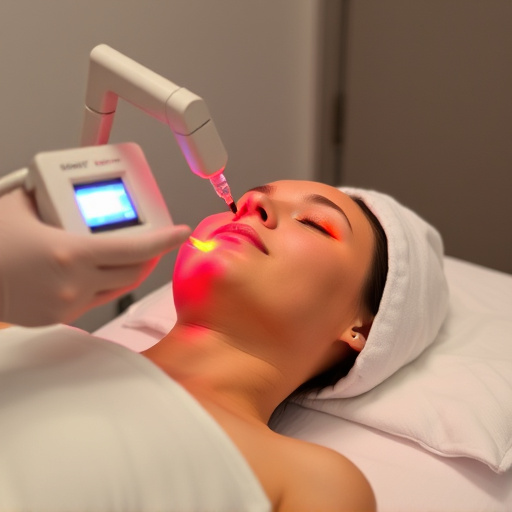Leg laser hair removal targets and destroys hair follicles non-invasively using specific light wavelengths, offering a long-lasting solution for smooth legs. The process involves multiple sessions spaced weeks apart, with results optimized by considering skin tone, hair thickness, and individual growth patterns. Consistent scheduling, qualified professionals, sun protection, and managed expectations are key to successful outcomes, which reduce but do not eliminate all hair permanently. Complementary procedures can enhance overall skin health alongside leg laser hair removal.
Looking to get rid of unwanted hair on your legs? Leg laser hair removal is a popular and effective solution. This article guides you through the process, reveals key factors determining the number of sessions needed, and offers tips to optimize results. From understanding the science behind it to maximizing efficiency, discover everything you need to know about leg laser hair removal for long-lasting smoothness.
- Understanding Leg Laser Hair Removal Process
- Factors Influencing Number of Required Sessions
- Optimizing Results: Tips for Effective Treatments
Understanding Leg Laser Hair Removal Process

The leg laser hair removal process involves using specific wavelengths of light to target and destroy hair follicles. This non-invasive procedure is designed to reduce unwanted hair growth over time, providing a long-lasting solution for smooth, hair-free legs. During the session, a specialized laser device emits light that penetrates the skin, where it’s absorbed by the melanin in the hair folicles, converting it into heat which damages or destroys the follicles, preventing them from producing new hair.
This treatment requires multiple sessions spaced several weeks apart to ensure optimal results. Each session builds upon the previous one, as the laser targets not only active follicles but also those in the dormant phase, ensuring a comprehensive approach to leg hair reduction. Along with its effectiveness in leg laser hair removal, this process is also known for its ability to contribute to skin rejuvenation and enhance overall aesthetic treatments, making it a popular choice among individuals seeking permanent solutions for their body hair concerns.
Factors Influencing Number of Required Sessions

The number of sessions required for leg laser hair removal varies based on several factors. Skin tone and hair thickness are two key determinants. Darker skin tones may need more sessions as lasers work best with contrast, while finer hairs will require fewer treatments as they absorb light less intensely. Generally, it’s recommended to start with a series of 6-8 sessions spaced about 4-6 weeks apart for optimal results.
Other considerations include previous hair removal methods and individual growth patterns. Those who’ve previously undergone waxing or shaving may observe different outcomes compared to those new to leg laser hair removal. Moreover, anti-aging treatments, facial treatments, and body contouring procedures can also influence the process, as they may change skin texture and hair folicle activity.
Optimizing Results: Tips for Effective Treatments

Optimizing results with leg laser hair removal requires a strategic approach. Each individual’s skin and hair growth patterns are unique, so it’s essential to plan your treatments accordingly. Typically, multiple sessions are necessary to achieve long-lasting hair reduction. On average, 6 to 8 sessions spaced several weeks apart are common recommendations for optimal results. However, some people may require more or fewer sessions based on factors like skin tone and hair thickness.
To ensure effective leg laser hair removal, consider these tips: maintain consistent scheduling between sessions, use a qualified professional, and protect your skin from the sun before and after treatments. Additionally, managing expectations is vital; while laser hair removal significantly reduces hair growth, it doesn’t eliminate all hairs permanently. For those interested in addressing related concerns, exploring complementary procedures like acne treatments or wrinkle reduction can enhance overall skin health and texture alongside successful leg hair removal.
Leg laser hair removal is a safe and effective method to achieve long-lasting reduction in unwanted hair. The number of sessions required varies based on skin type, hair density, and individual factors. On average, 4-6 treatments are needed for optimal results. By understanding the process, optimizing your preparation, and following professional tips, you can enhance the effectiveness of each session, leading to smoother, hair-free legs for months to come.














